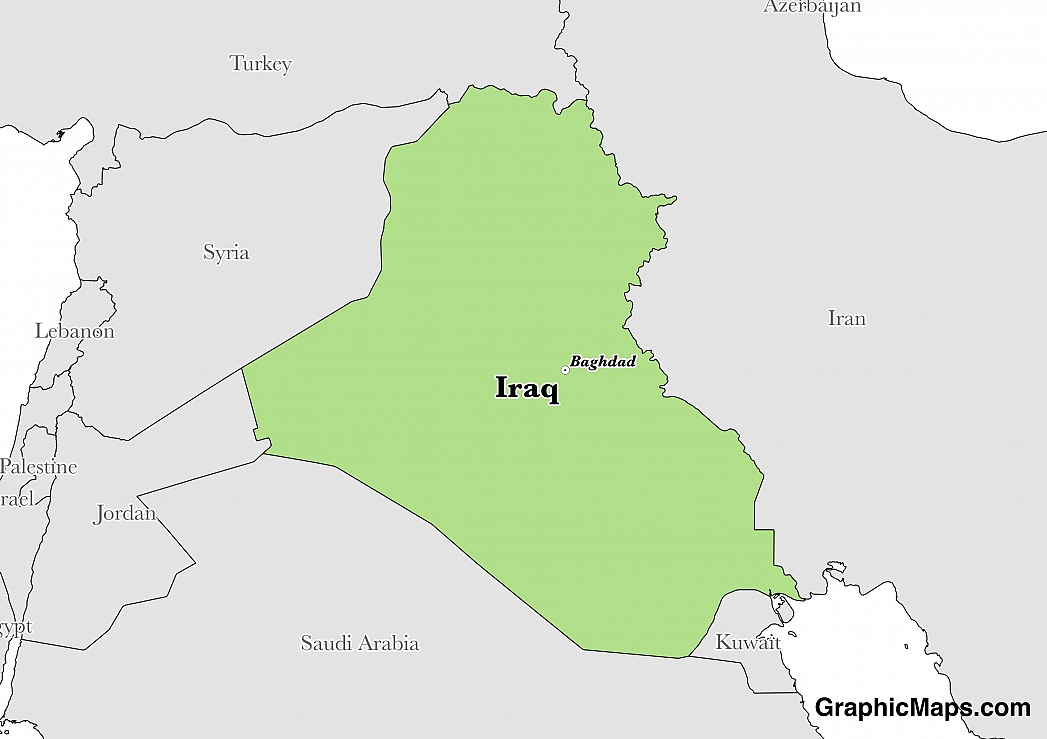Where is Iraq?
Located in the Middle East, Iraq has a 3,809.00 km border with Iran (1,599 km), Jordan (179 km), Kuwait (254 km), Saudi Arabia (811 km), Syria (599 km) and Turkey (367 km). It has a 58.00 km coastline. Iraq's lack of a maritime boundary with Iran often prompts jurisdiction disputes.
Baghdad is the largest and capital city of Iraq and has a population of approximately 8.8 million people. The city is divided into nine sectors, Adhamiyah, Karkh, Karrada, Kadhimiya, Mansour, Thawra, Al Rashid, Rusafa, and Tisaa Nissan. Baghdad is one of the oldest established cities in the world and has been a center for Islamic education and culture for centuries. The climate of Baghdad is classified as a subtropical desert climate, but temperatures vary significantly from summer to winter. Average lows in the middle of winter are 15.5 degrees Celsius (59.9 degrees Fahrenheit) and the average highs in the summer months reach 44 degrees Celsius (111 degrees Fahrenheit).
Read more on Iraq's CapitalIraq is an Asian country covering 438,317.00 km2 of which 0.22% is water and 437,367.00 km2 is land. This makes it the 58th largest country in the world and slightly more than three times the size of New York state. Its geographic coordinates are 33 00 N, 44 00 E and Baghdad is the capital city.
The name is said to derive from the word "Uruk", which was the ancient Sumerian and Babylonian city on the Euphrates River.
Its ISO code is IQ.
Geography
Iraq has a mean elevation of 312 m above sea level.
Its climate is mostly arid, with mild, cool winters and hot, cloudless summers. Its terrain mostly consists of broad plains, with some marshes along the Iranian border and mountains along the borders with Turkey and Iran.
Population
Iraq has a population of 38,146,025 making it the 36th largest in the world. The country's population is concentrated in the north, center, and eastern parts of the country.
Arabic and Kurdish are official languages. Major ethnic groups include Arab and Kurdish. Muslims make up the vast majority of religions.
The majority of the citizens of Iraq speak Mesopotamian Arabic but Kurdish is also an official language of the nation. Mesopotamian Arabic speakers make up approximately 75 to 80 percent of the entire population, and 20 percent of the population is known to speak Kurdish as their primary language. The Mesopotamian dialect of Arabic is mutually-intelligible with other Arabic languages of the area and is also split into two recognised branches within the country, namely the Gelet Mesopotamian Arabic and Qeltu Mesopotamian Arabic variations of the language. Minority languages in the country include Armenian, Feyli Lurish, Mandaic, Persian, and Shabaki with Assyrian Neo-Aramaic gaining official status in Northern Iraq.
Read more on Iraq's LanguagesThe dialing code for the country is 964.
Government
Iraq is an independent country. It gained independence from League of Nations mandate in 1932. Its constitution was last ratified in 2005.
The current constitution of Iraq defines the political system as a democratic, Islamic, federal parliamentary republic. The Council of Representatives and the Federation Council of Iraq hold legislative power and the prime minister of Iraq holds executive power. The present-day prime minister of Iraq is Haider Jawad Kadhim Al-Abadi who has also served previously as a Minister of Communication. The country holds free elections every four years, and the last national parliamentary election was held on April 30, 2014. The political system of Iraq is relatively fragile as democracy is a new phenomenon to many in the country. Saddam Hussein ruled this nation for almost 25 years with an iron fist, and many Iraqis are hesitant to get involved in politics due to past incidences of violence.
Read more on Iraq's GovernmentEconomy
Factoring in Purchasing Power Parity, Iraq's GDP is $597,000,000,000.00 (USD) with $16,500.00 (USD) per capita. This makes it the 35th largest economy and its citizens the 97th richest in the world. The currency of Iraq is the Dinar (IQD).
Its major export partners are China, India, and South Korea. Its main exports are crude oil and crude materials. Its major import partners are Turkey, Syria, and China. Its major imports include food, medicine, and manufactures.
Flag
The current Iraqi flag has three equal horizontal stripes in red, white, and black and also contains Arabic calligraphy in green in the center. The characteristics of this flag are inspired by the Arab Revolt against the Ottoman Empire during World War I. The current version of the flag was introduced in 2008. The original Pan-Arab colours on many Arab nations flags were a symbolic composition by a British diplomat by the name of Sir Mark Sykes.
Read more on Iraq's FlagThis page was last modified on January 17th, 2018
More on Graphicmaps

Published on 2019-11-06
What is a Trade Embargo?

Published on 2019-11-04
Which Two Countries Used to Have the Same Flag?

Published on 2019-09-16
What Is the Only Two-Sided State Flag?

Published on 2019-09-16
Which Country Flag Looks Like the Texas Flag?

Published on 2019-08-29
Flags That Resemble the US Flag

Published on 2019-08-20
